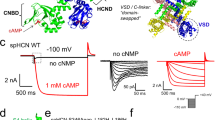Abstract
The effects of W7, a calmodulin (CaM)-inhibitor, and cyclic nucleotides on electrical coupling and uncoupling are studied in crayfish lateral giant axons (septate axons). The septate axons provide a relatively simple two cell system in which both surface membrane and junctional resistance can be measured independently. Four microelectrodes are inserted into a septate axon, two on each side of the septum. Hyperpolarizing current pulses (150 nA) are injected alternatively in the caudal and rostral axon segment and the resulting electrotonic potentials are recorded. The axons are uncoupled at regular intervals by superfusing them with acetate-containing saline solution (pH 6.3) in the presence or absence of W7 (50–100 μM) or, as a control, its nonchlorinated form (W5). W7 strongly inhibits the acetate-induced increased in junctional resistance, while W5 is ineffective. The uncoupling inhibition does not appear to be caused by an increase in cyclic nucleotide concentration, because in preliminary experiments exposure to db-cAMP or db-cGMP (up to 1 mM) does not seem to influence either the basic values of Rj or their changes with acetate. The data confirm previous evidence for a participation of CaM-like proteins in cell-to-cell channel gating.
Similar content being viewed by others
References
Bennett MVL (1966) Physiology of electrotonic junctions. In: Biological membranes: recent progress. Ann NY Acad Sci 137:509–539
Cole WC, Garfield RE (1985) Alterations in coupling in uterine smooth muscle. In: Bennett MVL, Spray DC (eds) Gap junctions. Cold Spring Harbor Laboratory, Cold Spring Harbor, pp 215–230
DeMello WC (1984) Effect of intracellular injection of cAMP on the electrical coupling of mammalian cardiac cells. Biochem Biophys Res Commun 119:1001–1007
Flagg-Newton JL, Dahl G, Loewenstein WR (1981) Cell junction and cyclic-AMP. 1. Upregulation of junctional membrane permeability and junctional membrane particles by administration of cyclic nucleotide or phosphodiesterase inhibitor. J Membr Biol 63:105–121
Garland D, Russell P (1984) Phosphorylation of lens fiber cell membrane porteins. Proc Natl Acad Sci USA 82:653–657
Girsch SJ, Peracchia C (1985a) Lens cell-to-cell channel protein: I. Self-assembly into liposomes and permeability regulation by calmodulin. J Membr Biol 83:217–225
Girsch SJ, Peracchia C (1985b) Liposome-incorporated liver gap junction channels are less permeable than lens channels. Biophys J 47:507a
Hertzberg EL, Gilula NB (1981) Liver gap junctions and lens fiber junctions: Comparative analysis and calmodulin interaction. Cold Spring Harbor Symp Quant Biol 46:639–645
Hidaka H, Sasaki Y, Tanaka T, Endo T, Ohno S, Fujii Y, Nagata T (1981) N-(6-Aminohexyl)-5-chloro-1-naphthalenesulfonamide, a calmodulin antagonist, inhibits cell proliferation. Proc Natl Acad Sci USA 78:4354–4357
Johnston MF, Ramón F (1981) Electrotonic coupling in internally perfused crayfish segmented axons. J Physiol (Lond) 317:509–518
Lasater E, Dowling J (1985) Dopamine decreases conductance of the electrical junctions between cultured retinal horizontal cells. Proc Natl Acad Sci USA 82:3025–3029
Lees-Miller JP, Caveney S (1982) Drugs that block calmodulin activity inhibit cell-to-cell coupling in the epidermis of tenebris molitor. J Membr Biol 69:233–245
Lehrer SS, Laevis PC (1976) Fluorescence and conformational changes caused by proton binding to troponin C. Biochem Biophys Res Commun 58:159–165
Louis CF, Johnson R, Johnson K, Turnquist J (1985) Characterization of the bovine lens plasma membrane substrates for cAMP-dependent protein kinase. Eur J Biochem 150:278–286
Loewenstein WR (1981) Junctional intercellular communication: the cell-to-cell membrane channel. Physiol Rev 61:829–913
Peracchia C (1984) Communicating junctions and calmodulin. Inhibition of electrical uncoupling inXenopus embryo by calmidazolium. J Membr Biol 81:49–58
Peracchia C (1985) Cell coupling. In: Martonosi A (ed) The enzymes of biological membranes, vol 1. Plenum Press, New York, pp 81–130
Peracchia C (1986) Effects of a calmodulin inhibitor (W-7) and cyclic nucleotides on electrical uncoupling of crayfish septate axons. Biophys J 49:338a
Peracchia C, Bernardini G (1984) Gap junction structure and cell-to-cell coupling regulation. Is there a calmodulin involvement? Fed Proc 43:2681–2691
Peracchia C, Girsch SJ (1985) Functional modulation of cell coupling: evidence for a calmodulin-driven channel gate. Am J Physiol 248:H765-H782
Peracchia C, Bernardini G, Peracchia LL (1981) A calmodulin inhibitor prevents gap junction crystallization and electrical uncoupling. J Cell Biol 91:124a
Peracchia C, Bernardini G, Peracchia LL (1983) Is calmodulin involved in the regulation of gap junction permeability? Pflügers Arch 399:152–154
Piccolino M, Neyton J, Gershenfeld HM (1984) Decrease of gap junction permeability induced by dopamine and cyclic adenosine 3′,5′-monophosphate in horizontal cells of turtle retina. J Neurosci 4:2477–2488
Pundak S, Roche RS (1984) Tyrosine and tyrosinate fluorescence of bovine testes calmodulin: calcium and pH dependence. Biochemistry 23:1549–1555
Saez JC, Spray DC, Hertzberg EL, Nairn AC, Greengard P, Bennett MVL (1986) The principal gap junction polypeptide is a phosphoprotein: its phosphorylation and junctional conductance are stimulated by cAMP. Biophys J 49:202a
Steiner RF, Lamboy PK, Sternberg H (1983) The dependence of molecular dynamics of calmodulin upon pH and ionic strength. Arch Biochem Biophys 222:158–169
Teranishi T, Negishi K, Kato S (1983) Dopamine modulates S-potential amplitude and dye-coupling between external horizontal cells in carp retina. Nature (Lond) 301:243–246
Van den Eijden-van Raaij AJM, de Leeuw ALM, Broekhuyse RM (1985) Bovine lens calmodulin. Isolation, partial characterization and calcium-independent binding to lens membrane proteins. Curr Eye Res 4:905–912
Van Eldik LJ, Hertzberg EL, Berdan RC, Gilula NB (1985) Interaction of calmodulin and other calcium-modulated proteins with mammalian and arthropod junctional membrane proteins. Biochem Biophys Res Commun 126:825–832
Watanabe A, Grundfest H (1961) Impulse propagation at the septal and communicational junctions of crayfish lateral giant axons. J Gen Physiol 45:267–308
Welsh MJ, Aster JC, Ireland M, Alcala J, Maisel H (1982) Calmodulin binding to chick lens gap junction protein in a calcium-independent manner. Science 216:642–644
Wojtezak J (1982) Influence of cyclic nucleotides on the internal longitudinal resistance and contractures in the normal and hypoxic mammalian cardiac muscle. J Mol Cell Cardiol 14:259–265
Wojtczak JA (1985) Electrical uncoupling induced by general anesthetics: a calcium-independent process? In: Bennett MVL, Spray DC (eds) Gap junctions. Cold Spring Harbor Laboratory, Cold Spring Harbor, pp 167–175
Author information
Authors and Affiliations
Rights and permissions
About this article
Cite this article
Peracchia, C. Calmodulin-like proteins and communicating junctions. Pflugers Arch. 408, 379–385 (1987). https://doi.org/10.1007/BF00581132
Received:
Accepted:
Issue Date:
DOI: https://doi.org/10.1007/BF00581132




